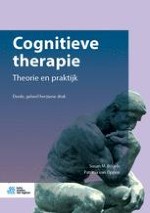Samenvatting
Sociale angststoornis is een van de meest voorkomende angststoornissen. Het is een aanhoudende angst om kritisch beoordeeld te worden in sociale situaties. Vooral het sociaal contact met anderen – van luchtige gesprekjes, meningsverschillen met vrienden tot professionele sociale situaties op het werk – boezemt deze patiënten angst in, maar ook het gebruik van sociale media kan spanning oproepen. Bij de behandeling zal de therapeut zich moeten verdiepen in de gevreesde sociale onhandigheden, de angstreactie, onvaardig gedrag en met name de verwachte afwijzing die de patiënt vreest. Verder is het de uitdaging om het specifieke veiligheidsgedrag in kaart te brengen en om te vormen tot open sociaal gedrag. Er staat de therapeut een aantal krachtige cognitieve technieken ter beschikking om de drie essentiële factoren (disfunctionele gedachten, zelfgerichte aandacht en veiligheidsgedrag) die de klachten versterken en in stand houden, te bewerken.
